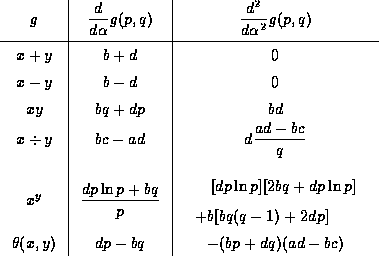The framework presented results in the two-step method,
which does not directly apply to the general exponentiation
function ![]() . With appropriate extensions, the two-step method
may generate valid bounds for
. With appropriate extensions, the two-step method
may generate valid bounds for ![]() but it will still
generate bounds which are not optimal.
but it will still
generate bounds which are not optimal.
With the two-step method an upper bound h, of g, was found;
h was then treated as a unary function so that our previous
methods may be applied.
We will remove the intermediate step, and consider g as a
unary function of ![]() :
:
![]()
The relevant derivatives appear in the table following.
Positive multiplicative factors were removed from some table entries.
Throughout the table ![]() while
while ![]() .
.

| Jeff Tupper | March 1996 |